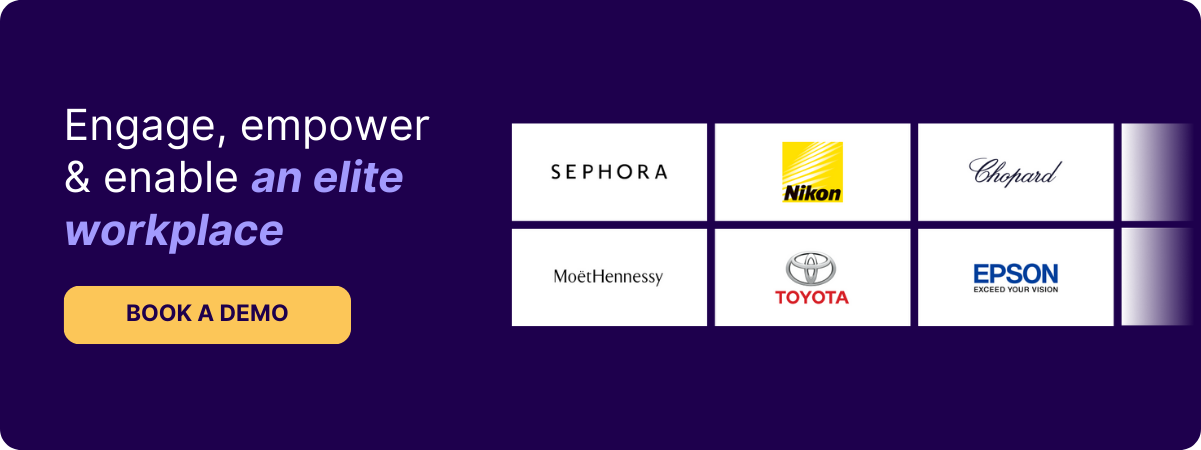Imagine a workplace where employees are genuinely happy, engaged, and motivated to do their best work. A place where teamwork thrives, turnover rates are low, and productivity is at an all-time high. A study says that companies with a highly engaged workforce can turn out to be 21% more profitable.
For that to be in place, it starts with employee engagement and monitoring it. Employee satisfaction surveys become essential at this time. In fact, according to a study by Gallup, the differences in employee engagement levels between top and bottom quartile business units were 18% higher in productivity and 81% lower in absenteeism.
By investing in your employee experience (EX), you're investing in the future of your organization. But if the costs are stopping you and you’re wondering how much an employee satisfaction survey costs, then read on!
This blog will discuss everything you need about employee satisfaction surveys and their costs.
Common types of employee satisfaction surveys
Before we dive into employee engagement survey pricing, let's understand the types of employee surveys that companies can leverage to improve employee satisfaction:
1. Pulse surveys
Pulse surveys are short, regular surveys conducted to monitor employee sentiment frequently. Organizations typically conduct pulse surveys once a month or once per quarter to keep an eye on the pulse of their employees' experiences. These surveys usually contain lesser questions (15-20) to avoid survey fatigue.
2. Annual engagement surveys
Employee engagement surveys are usually conducted annually and consist of around 50 questions. These surveys analyze various factors that impact employee satisfaction and engagement, including communication, leadership, work environment, and benefits. Companies that conduct employee engagement surveys and act on their results often significantly increase employee engagement and retention.
3. Custom surveys
Custom surveys are conducted as and when needed, usually in response to significant organizational events or initiatives. These surveys can be tailored to a specific topic, such as performance evaluations or workplace changes. They allow organizations to gather targeted feedback and insights from employees. For example, Forbes found that companies that conduct regular custom surveys to gather feedback on their rewards and recognition programs experienced 31% lower voluntary turnover.
💡 Keen on launching an effective employee satisfaction survey?
Talk to our experts today and get the answers you need. Discover best practices for crafting survey questions, analyzing results, and driving organizational change.
How much does an employee satisfaction survey cost?
If you are wondering how much an employee satisfaction survey costs, there is no straight answer, as it depends on certain factors. Since every organizational need is different, looking into the factors that affect their price is crucial.
1. The option of using a platform or hiring consultants
Organizations measuring employee satisfaction often face a vendor vs. consultant dilemma. Vendors offer real-time analytics, scheduling/automation, adaptable questionnaires, transparent costs, scientific methods, and AI adoption. In contrast, consultants provide a personalized approach but take longer to deliver results and may not have transparent pricing. Vendors are accurate and offer constant upgrades, while consultants juggle between software. Relying on vendors for surveys can be more efficient, cost-effective, and accurate than relying on consultants.
2. Platform capabilities
Platform capabilities are crucial for a smooth and efficient survey process. A robust dashboard is essential, providing an easy-to-use interface for HR leaders to monitor progress, view results, and generate reports. Custom report creation and automatic notifications are also important. Furthermore, survey setup and question libraries should be intuitive, with pre-built questions categorized by topic and relevance, to reduce time and effort.
3. Number of seats required
Determining the number of seats required is crucial to ensure that all stakeholders have access to the survey results. The number of seats required includes the number of admins and employees who will have access to the survey results. Admins are the ones responsible for managing the survey, creating the survey questions, and analyzing the data. Employees, on the other hand, are the ones who will take the survey and provide their feedback.
It is essential to determine the number of seats required because it affects the overall cost of the employee satisfaction survey. Having too many or too few seats can result in additional expenses or inadequate data collection, respectively.
EngageRocket's survey and feedback collection platform provide flexible seat management options that can be adjusted based on your organization's needs. It is essential to consider your current headcount, your projected growth, and the frequency of surveys to ensure that you select the right number of seats for your needs.
4. Level of support needed
As an organization, it's essential to assess your needs and work with your survey provider to determine the appropriate level of support. The good news is that many survey providers offer a range of support options, including phone and email support, online resources, and dedicated managers. Whether you need help setting up your survey, analyzing your results, or developing action plans, your provider should be there to guide you every step of the way.
The level of support you need will depend on the size and complexity of your organization, as well as your experience with employee satisfaction surveys. But with the right provider and support, you can ensure that your survey succeeds and that your employees feel heard and valued.
5. Level of customization
When it comes to employee satisfaction surveys, customization is key! Ensuring that your survey reflects your organization's unique culture and values is important. However, creating a custom survey can be a daunting task. This is where a robust platform with excellent design support comes in handy. A great platform should offer easy-to-use survey templates and customization tools, as well as support from experts who can help you design a survey that meets your organization's specific needs.
In addition to designing surveys, the right platform should also help you launch your survey and send reminders to ensure that you get the maximum participation rate. Some platforms also offer custom reporting and analysis to help you gain insight into your employees' feedback. All these features might require some level of customization, which may come at an additional cost. However, having a custom survey that reflects your organization's culture and values can go a long way in boosting employee engagement and improving job satisfaction.
💡 Looking for a better way to measure employee satisfaction?
Book a demo call with our team and see how our platform can help you design effective surveys and garner high participation rates.
Should you conduct employee satisfaction surveys yourself or use a platform?
1. Confidentiality
Confidentiality is critical to any employee satisfaction survey, and can be difficult to maintain if the survey is conducted in-house. Employees may be hesitant to provide honest feedback if they think their responses will not be kept confidential. On the other hand, a reliable employee feedback platform would have policies and procedures in place to ensure confidentiality.
2. Real-time insights
Data-driven insights are crucial to improving employee satisfaction, and a good platform can show you feedback as soon as they are collected. Platforms like EngageRocket also instantaneously collate the data to help you gain insights and make meaningful recommendations. We also offer powerful analytics tools that can help compare employee satisfaction between age groups, departments, and more.
3. Benchmarking
Even when data has been collected, how can organizations know how well they're doing in the industry? This is where benchmarking comes in.
Benchmarking is an essential aspect of employee satisfaction surveys, as it provides a means to compare your results against industry standards. EngageRocket has robust benchmarking systems in place so customers have access to a wide range of benchmark data that can help them measure their employee satisfaction against competitors.
4. Research-backed questionnaire
Designing research-backed questions can be a significant challenge for organizations conducting employee satisfaction surveys in-house.
It requires expertise in employee experience design and research methods. External vendors can provide pre-built survey questions that have been tested for reliability and validity. It provides access to a comprehensive library of pre-built survey questions to measure engagement, culture, and performance.
5. Launch time
Setting up and analyzing feedback collection is a time-consuming process. Conducting surveys in-house can be a significant burden on internal resources. A robust platform can help shorten set up time, thus reducing the burden on internal teams. Vendors streamline feedback collection, analysis, and management by automating the process, providing a centralized platform, data analysis and offering real-time monitoring and customization options, thus reducing the time of feedback collection.
EngageRocket's employee satisfaction survey solution
EngageRocket BELONG allows employers to ask a series of questions to their employees at any time. All of the questions in the question library are backed by research from EngageRocket's own People Science team. With its multi-device capability, BELONG can help organizations gain high participation rates and buy-in from all levels of the organization.
BELONG is also designed with confidentiality in mind, so employees can feel safe in sharing their opinions because their answers won’t be revealed to the employers. The analysis part is another very important part and one of our biggest strengths, because employers can get the insights they need in our analytics dashboard. We ensured everything is easy and fuss-free to use so it doesn’t feel like a chore for the already very busy managers, leaders and HR.
After collecting feedback, employers can gain meaningful insights from the data collected in BELONG's intuitive dashboard. Filter results by survey cycle, compare satisfaction between employee groups, and find out the impact of each driver on the overall satisfaction levels.





 .
. 